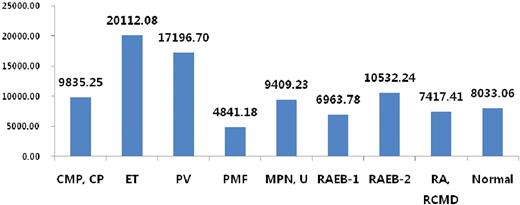Abstract
Abstract 4462
Telomere maintains genetic stability and cell replication by capping and protecting the end of the chromosomes. Telomere is synthesized by an enzyme called telomerase which contains a catalytic subunit, the human telomerase reverse transcriptase (hTERT). In this study, we compared the telomerase activity in two disease groups of distinctive pathophysiology - myeloproliferative neoplasm (MPN) and myelodysplastic syndromes (MDS) characterized by abnormally increased effective hematopoiesis and ineffective hematopoiesis resulting in intramedullary apoptosis, respectively. The result was also analyzed in association with the number of metaphase cells in conventional cytogenetic analysis.
Real time PCR to measure telomerase activity was performed using Quantitative Telomerase Detection kit (Allied Biotech, Inc., Ijamsville, MD) as per manufacturer¡&hibar;s instruction. The study included bone marrow cells of 99 normal controls, 114 with MPN (72 at initial diagnosis and 42 at follow up) and 73 with MDS patients (50 at initial diagnosis and 23 at follow up). MPN patients at initial diagnosis consisted of 22 CML in chronic phase, 18 ET, 11 PV, 12 PMF and 8 MPN, unclassifiable. MDS patients at initial diagnosis consisted of 19 RA or RCMD, 10 RAEB-1 and 13 RAEB-2.
A trend of decreasing telomerase activity was observed as age increases in normal controls: 8239.19 (molecules/reaction) in age under 70yrs vs. 6669.46 in age over 70yrs (p>.05). Telomerase activity was higher in those with clonal chromosomal abnormalities detected in conventional cytogenetic analysis than those without clonal abnormalities (47600.82 vs. 11729.21, p>.05). In those with clonal abnormalities, patients with clonal abnormalities in >50.0% of metaphase cells analyzed showed significantly higher telomerase activity than patients with clonal abnormalities in <50.0% of metaphase cells (19183.06 vs. 6077.40, p=.014). Telomerase activity in MPN was significantly higher than that in normal controls (12990.12 vs. 8033.06, p=.027). A decreasing order of telomerase activity was observed in ET, PV and CML (20112.08, 17196.70 and 9835.25), and PMF showed significantly low telomerase activity than other subtypes (p=.005). In contrast, MDS showed slightly lower telomerase activity than normal controls, however, the difference was not statistically significant (7170.66 vs. 8033.06, p>.05). Telomerase activity was the highest in RAEB-2 and the lowest in RAEB-1 in between, without statistical significance (10532.24 and 6963.78, p=.441).
High telomerase activity in patients with high clonal cell proportion in conventional cytogenetic analysis could be explained by the hypothesis that cells with high proliferative activity form metaphase cells easily. High telomerase activity in MPN and low telomerase activity in MDS reflect the abnormally increased hematopoiesis and the ineffective hematopoiesis in each disease. ET and PV showed higher telomerase activity than CML, which could be explained by further analysis in line with clinical findings of the patients other than disease subtype. Low telomerase activity in PMF might result from the scarcity of normal hematopoietic cells and the high apoptotic fraction of megakaryocytes compared with anti-apoptotic profile of ET cells. Our result suggests that the potential of telomerase inhibitors should be investigated in patients with high telomerase activity.
Comparison of telomerase activity in myeloproliferative neoplasm and myelodysplastic syndromes
Comparison of telomerase activity in myeloproliferative neoplasm and myelodysplastic syndromes
No relevant conflicts of interest to declare.
Author notes
Asterisk with author names denotes non-ASH members.


This feature is available to Subscribers Only
Sign In or Create an Account Close Modal